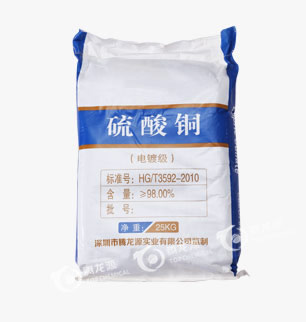Surface Treatment
Home-Product-Surface Treatment-Plating

Copper sulfate
Shape appearance:
Blue crystals.
Product Usage:
Used as an analytical reagent, for example, it can be used in biology to configure the Fehling reagent for identifying reducing sugars and the B-uret reagent for identifying proteins, but it is usually prepared for immediate use; used as a food-grade chelating agent and clarifying agent. In the production process of preserved eggs and wine; industrial field. Used in the manufacture of other copper salts such as cuprous chloride, copper chloride, copper pyrophosphate, cuprous oxide, copper acetate, copper carbonate, copper monoazo dyes such as reactive brilliant blue, reactive violet, etc.; in the coating industry for the production of ship bottoms Antifouling paint; electroplating industry used as the main salt and copper ion additive for all-bright acid copper plating; printing and dyeing industry used as mordant and fine dyeing cloth oxygen promoter; organic industry used as a catalyst for the synthesis of perfume and dye intermediates, methyl Polymerization inhibitor for methyl acrylate. Anhydrous salt is used to catalyze the conversion of acetal reaction. The anhydrous salt reacts with potassium permanganate to form an oxidant, which is used for the conversion of primary alcohols. In agricultural fields, Bordeaux mixture is mixed with lime water, which is used as a fungicide to control fungi on crops and prevent fruits from rot; because copper ions are toxic to fish, the dosage must be strictly controlled. The aquaculture industry is also used as the main raw material of feed additive trace element copper; used as a dehydrating agent for alcohols and organic compounds. Gas desiccant. In chemical education, copper sulfate is usually included in children's chemical experiment reagents for crystal formation experiments and copper electroplating experiments. Because of its toxicity, it is not recommended for young children. Copper sulfate can also be used to demonstrate the process of crystal loss and weathering and obtaining crystal water. In the junior high school laboratory examination, the substitution reaction between copper sulfate and iron was used to verify the law of conservation of mass. Can also prepare sulfuric acid. Used as an emetic in the medical field.
Blue crystals.
Product Usage:
Used as an analytical reagent, for example, it can be used in biology to configure the Fehling reagent for identifying reducing sugars and the B-uret reagent for identifying proteins, but it is usually prepared for immediate use; used as a food-grade chelating agent and clarifying agent. In the production process of preserved eggs and wine; industrial field. Used in the manufacture of other copper salts such as cuprous chloride, copper chloride, copper pyrophosphate, cuprous oxide, copper acetate, copper carbonate, copper monoazo dyes such as reactive brilliant blue, reactive violet, etc.; in the coating industry for the production of ship bottoms Antifouling paint; electroplating industry used as the main salt and copper ion additive for all-bright acid copper plating; printing and dyeing industry used as mordant and fine dyeing cloth oxygen promoter; organic industry used as a catalyst for the synthesis of perfume and dye intermediates, methyl Polymerization inhibitor for methyl acrylate. Anhydrous salt is used to catalyze the conversion of acetal reaction. The anhydrous salt reacts with potassium permanganate to form an oxidant, which is used for the conversion of primary alcohols. In agricultural fields, Bordeaux mixture is mixed with lime water, which is used as a fungicide to control fungi on crops and prevent fruits from rot; because copper ions are toxic to fish, the dosage must be strictly controlled. The aquaculture industry is also used as the main raw material of feed additive trace element copper; used as a dehydrating agent for alcohols and organic compounds. Gas desiccant. In chemical education, copper sulfate is usually included in children's chemical experiment reagents for crystal formation experiments and copper electroplating experiments. Because of its toxicity, it is not recommended for young children. Copper sulfate can also be used to demonstrate the process of crystal loss and weathering and obtaining crystal water. In the junior high school laboratory examination, the substitution reaction between copper sulfate and iron was used to verify the law of conservation of mass. Can also prepare sulfuric acid. Used as an emetic in the medical field.
- Previous:
- Nickel Sulfate
- Next:
- Carbon core
Product Description
Warehousing and transportation:
Avoid rain and hot sun during transportation. Be careful when loading and unloading to prevent damage to the package. In case of fire, water, sand, carbon dioxide fire extinguishers can be used to fight the fire. Store in a cool, ventilated warehouse. Keep away from fire and heat sources. The storage temperature does not exceed 30℃, and the relative humidity does not exceed 80%. The packaging should be complete when shipping, and the loading should be secure. During transportation, ensure that the container does not leak, collapse, fall, or be damaged. Mixed shipment and transportation with acids, alkalis, edible chemicals, etc. are strictly prohibited. Avoid exposure to the sun, rain, and high temperature during transportation. The vehicle should be thoroughly cleaned after transportation. The storage area should be equipped with leakage emergency treatment equipment and suitable storage materials.
Safety Precautions:
Closed operation, pay attention to ventilation. The operation is as mechanized and automated as possible. Operators must undergo special training and strictly abide by operating procedures. It is recommended that the operator wear a self-priming filter gas mask (full face mask), wear rubber acid and alkali resistant clothing, and wear rubber acid and alkali resistant gloves. Keep away from fire and heat sources, and smoking is strictly prohibited in the workplace. Prevent the vapor from leaking into the air in the workplace. When handling, load and unload with care to prevent damage to packaging and containers. Equipped with corresponding types and quantities of fire-fighting equipment and leakage emergency treatment equipment. Empty containers may be harmful residues. The operator wears labor protection equipment during use or transportation.
Avoid rain and hot sun during transportation. Be careful when loading and unloading to prevent damage to the package. In case of fire, water, sand, carbon dioxide fire extinguishers can be used to fight the fire. Store in a cool, ventilated warehouse. Keep away from fire and heat sources. The storage temperature does not exceed 30℃, and the relative humidity does not exceed 80%. The packaging should be complete when shipping, and the loading should be secure. During transportation, ensure that the container does not leak, collapse, fall, or be damaged. Mixed shipment and transportation with acids, alkalis, edible chemicals, etc. are strictly prohibited. Avoid exposure to the sun, rain, and high temperature during transportation. The vehicle should be thoroughly cleaned after transportation. The storage area should be equipped with leakage emergency treatment equipment and suitable storage materials.
Safety Precautions:
Closed operation, pay attention to ventilation. The operation is as mechanized and automated as possible. Operators must undergo special training and strictly abide by operating procedures. It is recommended that the operator wear a self-priming filter gas mask (full face mask), wear rubber acid and alkali resistant clothing, and wear rubber acid and alkali resistant gloves. Keep away from fire and heat sources, and smoking is strictly prohibited in the workplace. Prevent the vapor from leaking into the air in the workplace. When handling, load and unload with care to prevent damage to packaging and containers. Equipped with corresponding types and quantities of fire-fighting equipment and leakage emergency treatment equipment. Empty containers may be harmful residues. The operator wears labor protection equipment during use or transportation.






 13603024855
13603024855 Follow us
Follow us